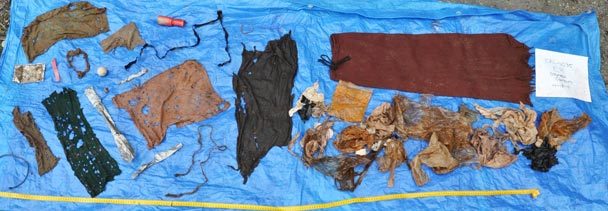
A gray whale that came ashore and later died near the Fauntleroy ferry dock last week had all that is pictured here in its stomach, all ingested while feeding in Puget Sound.
A gray whale's last meal in Puget Sound included plenty of trash, and it was fresh enough to indicate the animal took the "eat local" mantra enthusiastically to heart before coming ashore at Arroyo Beach, and later dying about a mile south of the Fauntleroy ferry dock.
In 20 years of examining more than 200 whale carcasses, research scientist John Calambokidis says Tuesday he has never seen so much trash in a whale's stomach. Founding member of the Cascadia Research Collective in Olympia, Calambokidis says he does not yet know what caused the whale's death, and tests are continuing.
"It kind of dramatizes the legacy of what we leave at the bottom," Calambokidis said. The sediment at the bottom of Puget Sound bays is loaded with other contaminants, "and an animal feeding and being exposed to this kind of garbage is also being exposed to those, too."
Gray whales are bottom feeders. They feed by stirring up great snoutfuls of mud, then shutting their mouths, and pressing the muck and water through a comb-like filter in their mouth. They swallow the remainder - usually crustaceans and other tiny fare. Debris ingested along with their meal where they usually feed in the Arctic typically include rocks or wood, and the animals pass them out of their system naturally.
But this whale, a 37-foot-long male, fed in Puget Sound's industrial waters, and had the goods to prove it. "We are viewing this as an indicator that what we do has an impact on other animals we share the planet with," Calambokidis said.
While it fed here, the whale is not believed to be among the small population of gray whales that regularly frequents Puget Sound's waters, particularly in the west end of the Strait of Juan de Fuca, and near Whidbey Island. Scientists know those animals by distinct markings, and this animal wasn't in that crowd.
Rather, this gray is believed to be one of the migrating whales streaming right now by Washington's outer coast, heading north from the calving lagoons in Baja, back to the animals' feeding grounds in the Bering and Chukchi seas in the Arctic.
A more than 4,000-mile journey each way, it's among the longest migration of any mammal, and the whales make the entire trip south and back again without eating. Some animals don't start out with a big enough fat pad, run out of fuel on the way home and duck into Puget Sound for a meal. But this whale did not seem to fit the emaciated look of that kind of desperation feeder, Calambokidis said.
Scientists will analyze its blubber and other tissues to determine if a disease killed the whale, and what, if any role, pollution played in its demise.
Puget Sound is actually cleaner than it used to be, the result of everything from volunteer beach cleanups to state and federal regulation requiring sewage treatment and restricting industrial discharges.
Sediment samples taken in Elliott Bay, the state's most urban waters, showed marked improvement in 2007 over the same sites sampled in 1997, according to Maggie Dutch, a benthic ecologist at the State Department of Ecology.
Levels of toxic metals such as mercury, lead and tin were all lower, as were levels of PCBs and some other chemicals. But others, such as plasticizers, were higher. The sediments beneath urban waters are the most affected by industrial pollution, of course. In other areas of the Sound, pollutant levels in the sediments are too low to even detect, Dutch said.
Tracking the pollutants is important because they travel up the food chain. The higher up the chain an animal eats, the more contaminated it is, because the toxins bioaccumulate. Orcas are about 10 times more contaminated than grays because they eat other marine mammals and fish, while grays are less affected because they subsist mostly on tiny crustaceans.
Gray whales suffered a large die-off in 1999-2000, with some 50 whales washing ashore in Puget Sound over those two years. Once overhunted nearly to extinction, the gray whales rebounded under the protection of the Endangered Species Act and were taken off the list of protected species in 1994. Their population is regarded as stable today, at about 20,000 animals.



Reader Comments
to our Newsletter